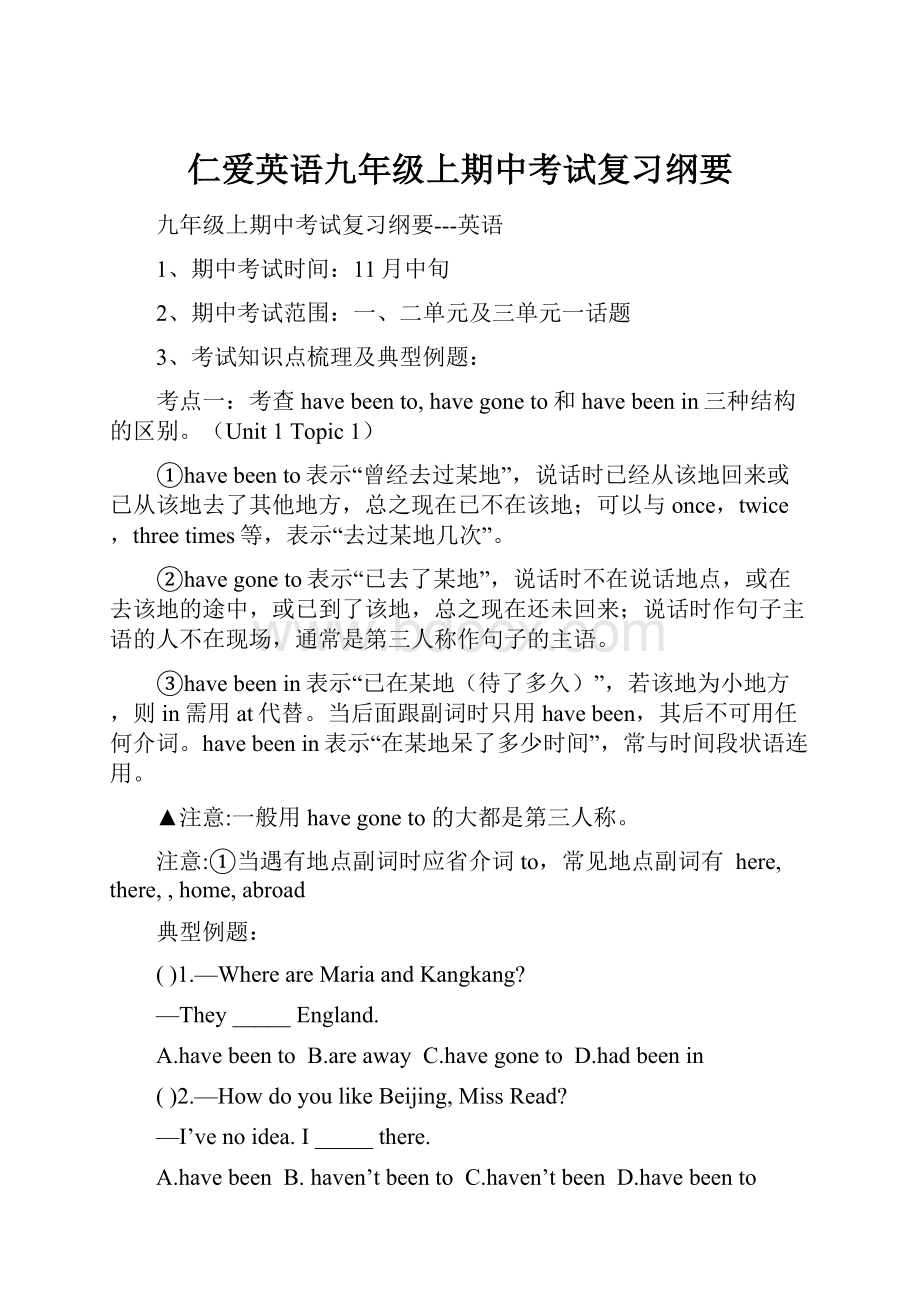仁爱英语九年级上期中考试复习纲要.docx
《仁爱英语九年级上期中考试复习纲要.docx》由会员分享,可在线阅读,更多相关《仁爱英语九年级上期中考试复习纲要.docx(15页珍藏版)》请在冰豆网上搜索。

仁爱英语九年级上期中考试复习纲要
九年级上期中考试复习纲要---英语
1、期中考试时间:
11月中旬
2、期中考试范围:
一、二单元及三单元一话题
3、考试知识点梳理及典型例题:
考点一:
考查havebeento,havegoneto和havebeenin三种结构的区别。
(Unit1Topic1)
①havebeento表示“曾经去过某地”,说话时已经从该地回来或已从该地去了其他地方,总之现在已不在该地;可以与once,twice,three times等,表示“去过某地几次”。
②havegoneto表示“已去了某地”,说话时不在说话地点,或在去该地的途中,或已到了该地,总之现在还未回来;说话时作句子主语的人不在现场,通常是第三人称作句子的主语。
③havebeenin表示“已在某地(待了多久)”,若该地为小地方,则in需用at代替。
当后面跟副词时只用havebeen,其后不可用任何介词。
have been in表示“在某地呆了多少时间”,常与时间段状语连用。
▲注意:
一般用havegoneto的大都是第三人称。
注意:
①当遇有地点副词时应省介词to,常见地点副词有 here,there,,home,abroad
典型例题:
()1.—WhereareMariaandKangkang?
—They_____England.
A.havebeentoB.areawayC.havegonetoD.hadbeenin
()2.—HowdoyoulikeBeijing,MissRead?
—I’venoidea.I_____there.
A.havebeenB.haven’tbeentoC.haven’tbeenD.havebeento
考点二:
:
before,just,never,ever,already,yet常用于现在完成时,用法如下:
副词
just
ever
never
already
yet
before
含义
刚刚
在任何时候,从来
从不
已经
否定句“还”
疑问句“已经”
以前
常用句型
陈述句
疑问句
陈述句
疑问句
否定句
陈述句
疑问句
肯定陈述句
否定句
疑问句
多种句型
常见位置
谓语动词前
谓语动词前
谓语动词前
谓语动词前或者句尾
句尾
句尾
注意:
still“仍,还”;still不用于现在完成时中。
典型例题:
()1.ThisisthemostbeautifulparkIhave_____visited.
A.everB.stillC.neverD.been
()2.—Haveyoufoundyourlostbook_____?
—No,Ihaven’t.
A.alreadyB.yetC.stillD.once
()3.—Haveyoucleanedyourroom_____?
—Yes,I’ve_____cleanedit.
A.already,alreadyB.yet,yetC.already,yetD.yet,already
考点三:
考查since和for用在现在完成时中的用法。
现在完成时用法二:
表示过去已经开始,持续到现在的动作或状态,也许还要继续下去。
常与
for或since引导的时间状语连用。
这时必须使用延续性动词。
I’veknownLiLeiforthreeyears.
We’velivedheresince2001.
△注意:
since和for的区别
由于since和for引导的时间都是持续性的一段时间。
Since后接过去的一个时间点,也可以接“一段时间+ago”,还可以接从句。
而for后只接时间段。
注意:
1.表示短暂性的动词在否定结构中可用现在完成时。
例:
Ihaven’tboughtanythingfortwomonths.
2.表示短暂性的动词完成时态不能和表示一段时间的时间状语连用,但是可以把短暂动词变成延续动词。
eg:
come-----beleave-----beawayfrom
buy------havedie------bedead
begin---beonborrow---keep
close------beclosedfallill-----beill
catchacold----haveacoldgettoknow---know
marry----bemarriedjoin-----beamemberof\bein
IhavecometoBeijingforhalfayear.(F)IhavebeeninBeijingforhalfayear.(T)
Hehaslefthomeforovertwoweeks(F)Hehasbeenawayfromhomeforovertwoweeks(T)
典型例题:
()1.—WhendidtheGreenscometoChina?
—They_____Chinaforsevenyears.
A.havecometoB.havebeentoC.havecomeinD.havebeenin
()2.Hurry up!
The play__________fortenminutes.
A.hasbegunB. hadbegunC. hasbeenonD. began
()3.—Howlonghashe_____fromhome?
—Foreightdays.
A.leftB.beenawayC.beawayD.leave
考点四:
考查现在完成时与一般过去时的区别。
现在完成时
一般过去时
结构
have/has+done(过去分词)
Was/were/did
时间状语
常与just,already,ever,never等副词和thesedays,sofar,recently,inrecentyeas,inthepastfewyears,since+时间点,for+时间段等表示一段时间的状语连用。
一般过去时通常与表示过去的时间状语连用。
如:
yesterday,lastweek,
twoyearsago,justnow,
in2002,inthepast等;
注意
不用when引导的疑问句连用,可以与where,why引导的疑问句连用
对一段时间提问用“Howlong”
可以与when引导的疑问句
连用
典型例题:
()1.—HowlonghaveyoubeeninBeijing?
—_____
A.Fiveyearsago.B.Sincefiveyearsago.C.Forfiveyearsago.D.Sincefiveyears.
()2.—Haveyouseenmybrother?
—Yes.I_____himinthelibraryfiveminutesago.
A.metB.havemetC.meetD.havebeenmet
()3.—_____you_____yourhomeworkyet?
—Yes,I_____ittenminutesago.
A.Did,do,finishedB.Have,done,havefinished
C.Have,done,finishedD.Will,do,finish
考点五:
so引导的完全倒装句(Unit1Topic2)
结构:
so+be/助动词/情态动词+主语表示“……也是一样”,意为“A如此,B也如此。
”
Heisanhonestboy,andsoamI.他是一个诚实的男孩,我也是。
Hesawthekites,andsodidI.他看见那些风筝了,我也看到了。
HehasbeentoBeijing.SohaveI.他去过北京,我也去过。
(现在完成时,其助动词是have/has)
注意:
此句型只用于肯定句。
否定句要用“neither/nor+be/助动词/情态动词+主语”。
如:
—Hecant’tspeakRussian.他不会讲俄语。
—Neither/NorcanI.我也不会讲俄语。
辨析:
so+主语+be/助动词/情态动词
此句型不是倒装句,只是单纯地重复前面一句的意思,表示“的确如此、就是这样”。
典型例题:
()1.—HaveyourparentsbeentoRussia?
—Yes.So_____I.
A.doB.havebeenC.didD.have
()2.—Ihavenevervisitedapaperfactory.
—_____
A.SohaveI.B.SoIhave.C.NeitherhaveI.D.Ihaven’tnow.
()3.—Davidhasmadegreatprogressrecently.
—_____,and_____.
A.Sohehas,soyouhaveB.Sohehas,sohaveyou
C.Sohashe,sohaveyouD.Sohashe,soyouhave
考点六:
人口population
1.问人口的多少用what而不用howmany。
What'sthepopulationof...?
....人口是多少?
(注意时态)
2.population是不可数名词,所以用that代替。
3.population为“人口,居民”的意思,常用形容词large或small来表达人口的多少。
典型例题:
()1.—_____thepopulationoftheU.S.A.in2005?
—It_____about296million.
A.Whatis;isB.Whatwas;was
C.Howmanyis;wasD.Howmanywas;is
()2.ThepopulationofShanghaiislargerthan_____ofShenyang.
A.thatB.itC.oneD.this
()3.—Whichcountryhasthe_____populationintheworld?
—China.
A.smallestB.mostC.largestD.large
()4.—Doyouknow_____?
—Sorry,Idon’tknow.
A.what’sthepopulationofJapanB.whatthepopulationofFranceis
C.howmuchofthepopulationofJapanisD.howmanyisthepopulationofFrance
考点七:
考查分数的表达法,其结构是分子为基数词,分母为序数词,分子大于1时,分母加s。
分数+of+名词可数名词复数谓语动词用复数
不可数名词谓语动词用单数
典型例题:
()1.Therearesixtyteachersinourschool._____ofthemarewomen.
A.TwothirdB.TwothreesC.TwothirdsD.Secondthree
()2.Inourclass_____ofthestudents_____girls.
A.thirdfifths,isB.thirdfifth,areC.threefifth,isD.threefifths,are
()3.oflandwater.
A.Twothird,isB.Twothirds,areC.Twothirds,isD.Twothirds,was
考点八:
反意疑问句:
结构:
陈述句+简短问句?
前肯定,后否定
前否定,后肯定
考查反意疑问句中简短问句部分的时态和人称的单复数要与陈述句部分一致。
典型例题:
练:
1.Thestudentshavecleanedtheclassroom,_____?
A.sothey B.don'tthey C.havethey D.haven'tthey
2.He’sreadthisbookbefore,________?
A.hasn’the B.doesn’theC.isn’the D.wasn’the
考点九:
1.考查多位数的基数词的读法:
多位数由右向左每3位有一个逗号,逆向第一个逗号读thousand,向左再推三位,第二个逗号读million;第三个逗号读billion。
逗号间的数字与读百位数相同。
百位与十位之间用and连接,十位与个位之间用“-”连接。
2.thousand前有具体数字时,不加s。
当它加s时,与of搭配成固定结构,表示“成千上万”。
hundredsof:
thousandsof:
millionsof:
billionsof:
典型例题:
()1.—Howmuchisthewhitecoat?
—It’s_____yuan.
A.onethousand,sixhundred,eighty-eight
B.onethousandsixhundredeighty-eight
C.onethousand,sixhundredandeighty-eight
D.onethousandandsixhundredandeighty-eight
()2.—Canyouwritethenumbereighty-fivethousand,sixhundredandtwenty-six?
—Yes,itis_____.
A.85,626B.856,620C.58,662D.58,626
()3.Xi’anisacitywithmanyplacesofinterestand_____touristscomehereeveryyear.
A.thousandofB.thousandC.thousandsD.thousandsof
考点十:
固定搭配
havebeento去过某地,已经回来了
hasgoneto去某地,还没有回来
receiveagoodeducation接受好的教育
keepintouchwithsb.与……保持联系
notonly...butalso...不仅...而且...
makeprogress取得进步
succeedindoingsth.成功做某事
takemeasurestodosth.采取措施做某事
millionsof数以百万计
workwellindoingsth.在某方面起作用
withapopulationof...有...人口
getusedtodoingsth.习惯于做某事
usedtodo过去常常
liveanormallife过正常的生活
haveaproblemwith…有某方面的问题
makeacontributiontodoingsth.为……作贡献
asaresult结果
encouragesb.todosth.鼓励某人做某事
therebe...doing...某地某物正在做某事
pour...into…向……投入……
cutdown砍倒
beharmfulto对……有害=doharmto
stopsb./sth.(from)doingsth.=preventsb./sth.(from)doingsth.阻止……做某事
keepsb./sth.fromdoingsth.阻止……做某事(from不能省略)
blowaway吹走
washaway冲走
takeaway拿走,取走
anumberof大量的
thenumberof...的数量
noneofus+三单没有一个人
avoiddoingsth./sth.避免做某事
can’twaittodo迫不及待做某事
onbusiness出差
besimilarto与……相似,与……相像
havetrouble(in)doingsth.做某事有麻烦
gettingalongwithsb.与...相处的好
考点十一:
不定代词和副词
不定代词:
不指明替代任何特定名词或形容词的代词。
大多数不定代词在句中可以做主语、表语、宾语、同位语和定语。
可数
不可数
许多
many
much
alotof,lotsof,plentyof
一些
Some,any
afew
alittle
几乎没有
few
little
每个
任何一个
全都
都不
另一个
指两者
each
either
both
neither
(the)other
两者以上
each/every
any
all
None/no
another
some-
any-
no-
every-
人
someone
anyone
noone/none
everyone
somebody
anybody
nobody
everybody
物
something
anything
nothing
everything
典型例题:
()1.Asweknow,_____ofuslikespollution.
A.nooneB.noneC.someoneD.nothing
()2.—Mike,where’stoday’snewspaper?
—Well,youdon’tneedtoreaditbecausethereis_____init.
A.somethinginterestingB.nothingspecial
C.importantthingD.anythingnew
()3._____iswatchingTV.Let’sturnifoff.
A.SomebodyB.AnybodyC.EverybodyD.Nobody
考点十二:
连词
and表示并列或顺承关系
or表示选择关系,或者表示“否则”
while表示对比,对照
典型例题:
1.It’sgoingtorain.You’dbettertakeanumbrella_____youmaygetwet.【长沙】
A.orB.andC.but
2.Ericarrivedontime,______itwastherushhour.【河北】
A.althoughB.becauseC.whileD.unless
3.Dianaisn’there,______leaveamessageonherdesk.【河北】
A.orB.soC.andD.but
4.Don’trunintheclassroom,______youmayhurtyourself.【陕西】
A.andB.orC.butD.so
5.I’dliketogowithyou,__
_____I’mtoobusy.【北京】
A.orB.andC.soD.but
6. He likes football _____ I like baseball.
A.althoughB.becauseC.whileD.unless
7.—Iamreallysorry,______Ican’tgoswimmingwithyouthisSunday.
—It’sOK,wecangotogethernexttime.
A.soB.andC.orD.but
考点十三:
一般现在时的被动语态
构成:
动作承受者+am/is/are+动词过去分词+by+动作执行者。
Englishisspokenbymanypeople.很多人都说英语。
Historyismadebythepeople.历史是人民创造的。
EnglishisspokenasthemainlanguageinAmerican.
SpanishisspokenastheofficiallanguageinCuba.
△被动语态的句型总结如下:
①肯定句:
主语+be+过去分词+(by~~).
TheboyiscalledJack.
②否定句:
主语+benot+过去分词+(by~~).
Thebabyisnotlookedafterbyhisfather.
③一般疑问句:
Be+主语+过去分词+(by~~)?
IsKingLearwrittenbyShakespeare?
④特殊疑问句:
特殊疑词+be+过去分词+(by~~)?
Whatisthiskindofsweatermadeof?
典型例题:
Englishiswidelyusedaroundtheworld.
Englishisnotwidelyusedaroundtheworld.(改为否定句)
—IsEnglishwidelyusedaroundtheworld?
(改为一般疑问句)
—Yes,itis./No,itisn’t.(回答)
WhyisEn